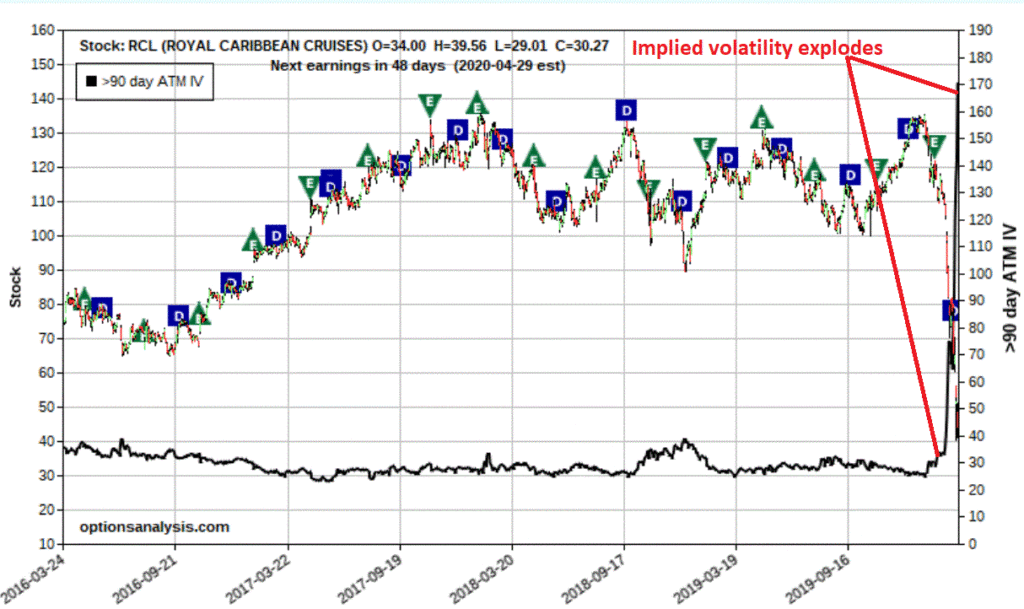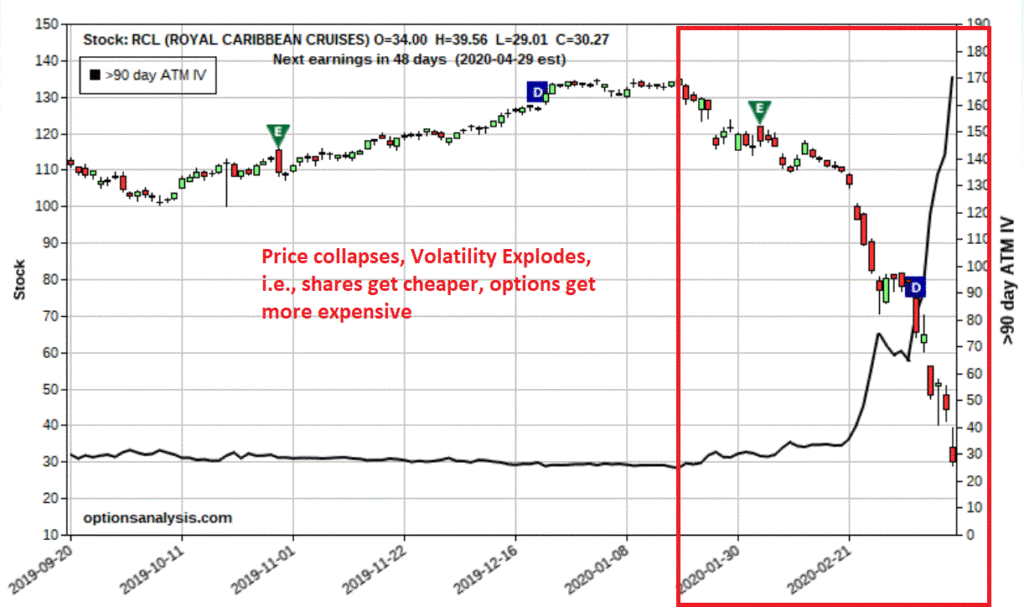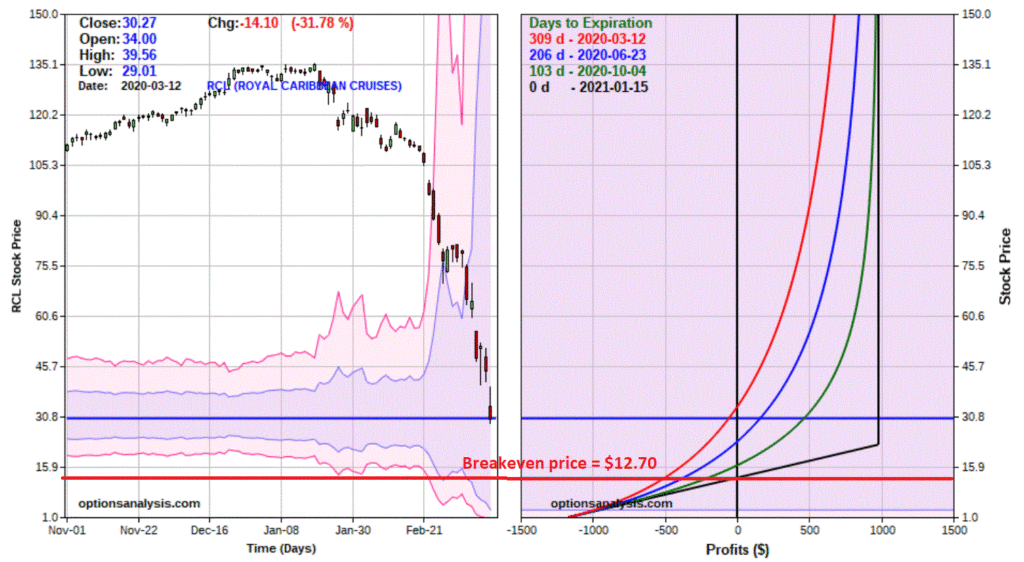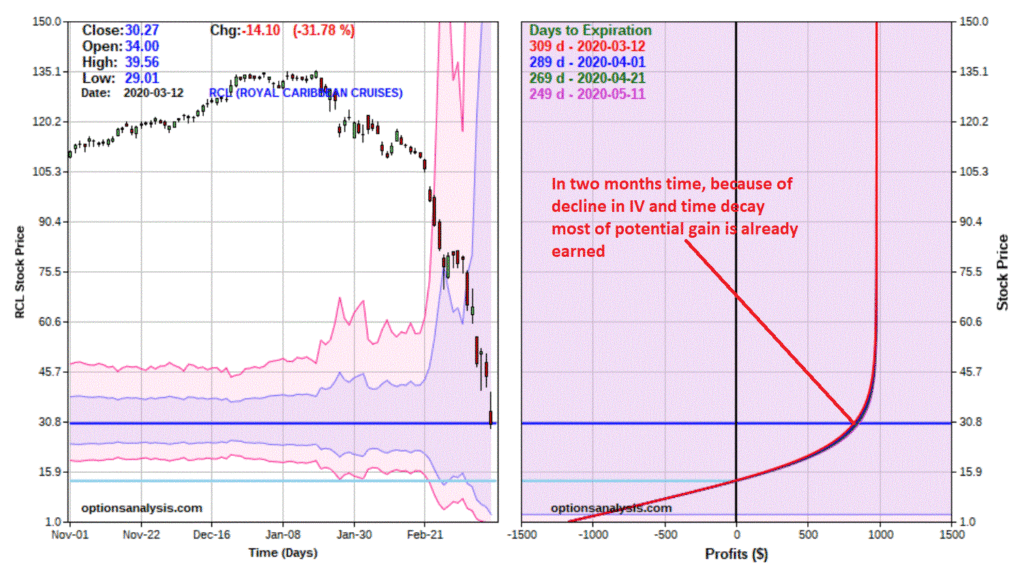With coronavirus now deemed a worldwide pandemic, it is not surprising that the stock prices for cruise ship lines have collapsed. This article does NOT contain a “recommendation”, but only seeks to detail one potential way to play this particular situation.
For the record, possibly the wisest course of action is to stay away from cruise stocks (and cruise ships for that matter, but I digress). But in every situation, there is opportunity. Recently I posted this article suggested that the average option buyer should tread lightly, due to the fact the option implied volatility has exploded in recent weeks, vastly inflating the amount of time premium – and thus the price of, options in general. This makes them “expensive” to buy.
It can also make them very lucrative to sell. Like I said, in every situation there is opportunity.
Selling a Cash Secured Put
Let’s look at an example using Royal Caribbean (RCL). The strategy is called a “cash secured put”. In simple terms:
*You sell an out-of-the-money put option (i.e., one with a strike price below the stock’s price)
*You also make sure that you have enough cash in your account to buy 100 shares of stock at the strike price
Then you wait and one of several things happens:
*The stock is above the option strike price at option expiration and you keep the premium you received when you sold the option
*The stock is below the option strike price at option expiration and you buy the stock at the strike price, but still keep the premium you received when you sold the option – which serves to reduce the effective purchase price of the shares
*You buy back the put option prior to option expiration (usually done if the option can be bought back at a cheaper price than the price it was originally sold)
The idea time to do this is when:
*You are looking at a relatively low-priced stock (so you don’t have to tie up as much cash as you would with a very high-priced stock)
*Implied option volatility is extremely high (because that is when the most premium is available)
Figure 1 displays RCL stock price and 90+-day option implied volatility (black line) four about 4 years.
The historical range is roughly 30% to 40% – now > 150%!

Figure 1 – RCL price and implied volatility (High IV makes options “expensive”) (Courtesy www.OptionsAnalysis.com)
Figure 2 zooms in on Figure 1

Figure 2 – RCL price and implied volatility (Courtesy www.OptionsAnalysis.com)
A few things to note:
*RCL has obviously “crashed” in price
*Implied volatility is at potentially a once in a lifetime level (i.e., RCL options are “expensive”)
The problem with just buying RCL stock right here is that no one knows “how low is low”. So, we will go a different route, but first a little more pesky “options education.”
A Quick Lesson in The Effect of Changes in Volatility on Time Premium
*Longer-term options have more time premium built into their price than shorter-term options. This is simply because an option writer is going to demand more premium to write (and be exposed to the risk of being short an option) a longer-term option than a shorter-term option.
*The option Greek “Vega” tells us how much time premium (in dollars) an option (or combined position) will gain or lose if implied volatility rises one full percentage point. More on this in a moment.
*Longer-term options have a higher Vega than shorter term options, and their prices will swing more based on changes in IV that shorter-term options.
An RCL Hypothetical Position
*Just a reminder, I am not “recommending” this trade, just using it as an interesting (well, OK if you are an option geek like me) example.
*For our trade we are going to sell (or sell short, or “write”) the January 2021 22.5 strike price put option.

Figure 3 – RCL Cash Secured Put (Courtesy www.OptionsAnalysis.com)
Things to note:
*This option is trading at an implied volatility (IV) of 140.2% (glance again at Figures 1 and 2 to note the historical range for RCL IV)
*This option does not expire until January 15, 2021, or 309 days from now
*This option has a “Vega” of -$7.09 (this means that IV rises one full percentage point this position will lose roughly -$7.09 and if IV FALLS one full percentage point this position will gain roughly $7.09. In other words, a decline in volatility will work in our favor)
*This option has a “Theta” of $1.82 (this means that we will gain roughly $1.82 per day due to time decay, i.e., the time premium for the option will decline by that amount per day)
*As this is written, RCL is trading at $30.27 a share
*We are going to assume that a limit order is used as that we get filled at the midpoint of the bid/ask range, and sell the put option at $9.80, thereby taking in $980 in premium
*Since we are selling a 22.5 strike price put, it means we need to have $2,250 (22.5 x 100 shares) in cash in our trading account to cover the potential cost of buying the shares
*However, this cost is reduced by the fact that we received $980 in premium for writing the option.
*This means that – in theory – if RCL is trading below $22.50 a share (or 25.7% below the current stock price) on January 15, 2021, we would be required to buy 100 shares of RCL at $22.50 a share. Again, however, because we received the premium, our effective purchase price would be:
Option Strike Price = 22.5 x 100 = $2,250
Minus the option premium received = $9.80
Net Cost = $12.70 a share or $1,270 for 100 shares
Figure 4 displays the risk curves for this position, and you can see the breakeven price of $12.70 a share.

Figure 4 – RCL short put risk curves
Two Other Possibilities
The big potential negative to note is this: If RCL is under the strike price at option expiration you must buy the shares at $22.50. Even if RCL fell to $1 a share you still need to buy the shares at $22.50 (although again, your net cost is $12.70). $12.70 looks pretty good when the stock is trading at $30.27 a share. But the key risk factor to note in this trade is that YES, you can lose money if the stock keeps falling.
For the record, in the worst case scenario, RCL goes bankrupt and the trader loses the entire $2,250.
The other possibility is to buy back the put option before it expires. This is once again where implied volatility becomes an important factor. Let’s suppose the following:
*At some point the RCL stock price decline “levels off”, i.e., it stops plunging for awhile
*When that happens, chances are great that implied volatility will decline. In this case – refer back to Figures 1 and 2 – implied volatility can fall a very long way
Now remember our discussion earlier (or better yet refer to the discussion in this article) about changes in IV. This position has a Vega of -$7.09, which means that it will lose a lot of time premium if IV falls.
(TECHNICAL NOTE: Greek values change from day to day as time passes and the price of the stock and the option fluctuate)
Example of Buying Back the Put Option Early
For example’s sake, let’s assume:
*Two months’ go by
*RCL stock price is unchanged
*IV falls from 140% to 40%
Because of time decay and the sharp decline in IV, a large portion of the current time premium will evaporate. This could give us the opportunity to buy back the put option at a profit and close the trade, rather than waiting around for January 2021.

Figure 5 – The effect of IV falling from 140% back to 40% (Courtesy www.OptionsAnalysis.com)

Figure 6 – RCL risk curves two months later assuming IV falls to 40% (Courtesy www.OptionsAnalysis.com)
Summary
Opportunity is where you find it. But everything entails risk. The example trade presented here has the potential to take advantage of the current levels of fear surrounding RCL stock by selling a far out of the money put option and ultimately either buying it back early at a profit or buying shares of RCL at $12.70 a share.
But remember, if RCL drops below that price, large losses can still occur
Jay Kaeppel
Disclaimer: The information, opinions and ideas expressed herein are for informational and educational purposes only and are based on research conducted and presented solely by the author. The information presented does not represent the views of the author only and does not constitute a complete description of any investment service. In addition, nothing presented herein should be construed as investment advice, as an advertisement or offering of investment advisory services, or as an offer to sell or a solicitation to buy any security. The data presented herein were obtained from various third-party sources. While the data is believed to be reliable, no representation is made as to, and no responsibility, warranty or liability is accepted for the accuracy or completeness of such information. International investments are subject to additional risks such as currency fluctuations, political instability and the potential for illiquid markets. Past performance is no guarantee of future results. There is risk of loss in all trading. Back tested performance does not represent actual performance and should not be interpreted as an indication of such performance. Also, back tested performance results have certain inherent limitations and differs from actual performance because it is achieved with the benefit of hindsight.


Thank you for this refresher course on Cash Secured Puts. I never realized that upon expiration, the strike price is debited at the strike price level even if the stock is significantly cheaper (lower) at expiration. That explains perfectly , why it may be advantages to buy the option back when the IV falls and the price wave calms.